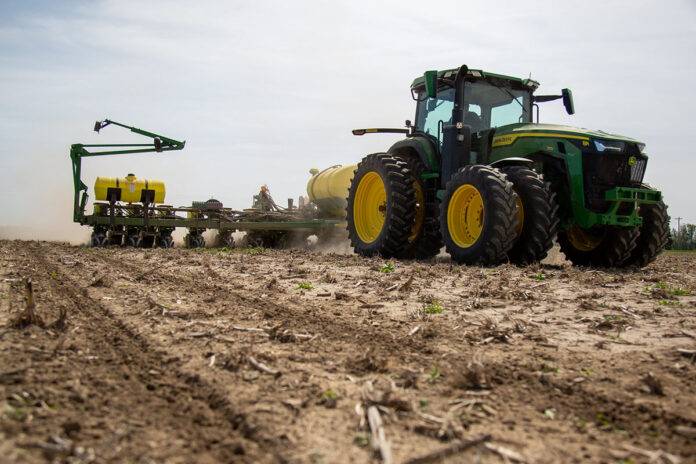Impact of Tariffs on U.S. Agriculture: A Growing Concern
SALEM, Ohio — On March 4, President Donald Trump’s tariffs against Canada and Mexico were officially implemented, alongside a significant increase in duties on Chinese goods, escalating tensions in trade relations with some of the United States’ most crucial trading partners. These tariffs have raised concerns among American farmers and agricultural stakeholders, particularly as the spring planting season approaches.
Starting just after midnight on March 4, imports from Canada and Mexico are now subject to a 25% tariff, with Canadian energy products facing a 10% duty, as reported by the Associated Press. In retaliation, China announced additional tariffs on a wide range of U.S. agricultural exports, effective March 10. This includes a 15% tariff on imports of U.S.-grown chicken, wheat, corn, and cotton, along with increased tariffs on sorghum, soybeans, pork, beef, seafood, fruits, vegetables, and dairy products.
Canadian Prime Minister Justin Trudeau responded swiftly, stating that tariffs on $20 billion worth of U.S. imports would take effect immediately. These include products such as orange juice, peanut butter, wine, beer, and various consumer goods. Trudeau further warned that Canada might impose tariffs on an additional $86 billion of U.S. imports if Trump’s tariffs remain in place for more than 21 days. Meanwhile, Mexican President Claudia Sheinbaum indicated plans to announce retaliatory tariffs on U.S. goods shortly thereafter.
Agricultural Implications
The full impact of these tariffs on American farmers remains uncertain; however, national agricultural advocacy groups have expressed significant concern regarding the pressures these trade policies will place on producers. National Farmers Union President Rob Larew emphasized the existing economic uncertainty within the farming community, stating, “We are already facing significant economic uncertainty, and these actions only add to the strain. Trade policies must come with real, tangible protections for the farmers directly affected.” He called for the administration to clarify its strategy, noting that promises alone will not suffice to sustain farmers’ operations.
The timing of these tariffs is particularly concerning, as the U.S. enters its spring planting season. Most of the U.S. potash supply, a critical ingredient in fertilizers, is imported from Canada. Corey Rosenbusch, President and CEO of The Fertilizer Institute, urged the Trump administration to exempt Canadian fertilizers from these tariffs by designating them as critical minerals. He warned that such trade restrictions could significantly increase costs for farmers, stating, “Maintaining reliable and cost-effective fertilizer supply chains is essential to ensuring a productive harvest and protecting American farmers from unnecessary financial strain.”
Zippy Duvall, President of the American Farm Bureau Federation, echoed these sentiments, calling for a swift resolution to the tariff issues with key agricultural trading partners. In 2022, U.S. agricultural exports to Canada, Mexico, and China exceeded $83 billion, highlighting the vital nature of these markets for American farmers. Duvall noted, “For the third consecutive year, farmers are losing money on almost every major crop planted. Adding even more costs and reducing markets for American agricultural goods could create an economic burden that some farmers may not be able to bear.”
On March 3, Trump further announced to American farmers that tariffs on “external products” would take effect in April, though the specifics of this announcement remained unclear. “To the Great Farmers of the United States: Get ready to start making a lot of agricultural product to be sold INSIDE of the United States. Tariffs will go on external product on April 2nd. Have fun!” he stated on his social media platform.
Background of the Tariff Policy
These tariffs on Canada and Mexico were initially set to begin in February but were postponed for 30 days to allow for additional negotiations. The administration has cited the need to address issues related to drug trafficking and illegal immigration as justification for the tariffs, with both Canada and Mexico asserting that they have made progress in these areas.
Trump has consistently indicated a desire to eliminate trade imbalances in the Americas and to incentivize domestic manufacturing through tariffs. He argued, “It’s going to be very costly for people to take advantage of this country. They can’t come in and steal our money and jobs and expect not to be punished, and they’re being punished by tariffs.” He further described tariffs as a powerful tool that previous administrations had failed to utilize effectively.
Conclusion
As the situation continues to evolve, the ramifications of these tariffs on American agriculture are likely to unfold. Farmers and agricultural advocacy groups are urging the administration to consider the significant financial pressures that these trade policies may impose on producers. With the planting season upon us and an uncertain market landscape, the agricultural sector is bracing for the potential challenges ahead. The coming months will be critical in determining the long-term impacts of these tariffs on the U.S. farming community.




